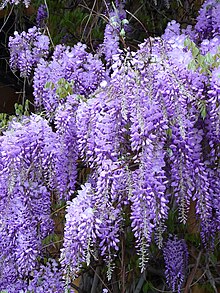紫藤属
紫藤属(学名:Wisteria),豆科蝶形花亚科下的一属。紫藤属下有数十种[1],皆属攀缘植物,原产于东亚与北美洲。本属许多种类是受欢迎的园艺植物,部分物种引进北美洲后成为当地的入侵物种。全株都可能有毒性,尤以种子毒性最高。东西方的许多艺术作品中均有出现紫藤的元素。
| 紫藤属 | |
|---|---|

| |
| 中国紫藤的花 | |
| 科学分类 | |
| 界: | 植物界 Plantae |
| 演化支: | 维管植物 Tracheophyta |
| 演化支: | 被子植物 Angiosperms |
| 演化支: | 真双子叶植物 Eudicots |
| 演化支: | 蔷薇类植物 Rosids |
| 目: | 豆目 Fabales |
| 科: | 豆科 Fabaceae |
| 亚科: | 蝶形花亚科 Faboideae |
| 族: | 崖豆藤族 Millettieae |
| 属: | 紫藤属 Wisteria Nutt. |
| 物种 | |
| |
| 异名 | |
| |
命名
编辑发表、命名紫藤属的植物学家托马斯·纳托尔表示属名Wisteria是纪念著名医师卡斯帕·威斯塔对科学的贡献而取[2][3],当有人对Wistar与Wister字尾拼写不同提出疑问时,纳托尔回答是为了让声调听起来更和谐,不过其传记的作者怀疑这个学名有可能与托马斯的好友Charles Jones Wister, Sr有关[4]。因为此拼写错误显然是纳托尔有意为之,根据国际藻类、真菌、植物命名法规,此名也没有改为Wistaria的必要[5],不过仍有人将其拼写成Wistaria,例如当代英文用法词典便采取此用法[6][7]。
外观与生理
编辑紫藤属植物的生长方式是将其茎顺时针或逆时针地环绕任何可提供支持的结构,本属最常见的两物种中,日本紫藤的缠绕方式由上往下看是顺时针,中国紫藤则是逆时针,这种差别有助于分辨这两种物种[9]。紫藤属植物可攀爬高达20米,并向侧面延展10米。世界上最大株的紫藤属植物是一株1894年栽种、位于美国加州马德雷的中国紫藤,全株延伸的面积超过一英亩[10]。紫藤属植物的叶呈互生,长15-35公分,羽状复叶上有9-19片小叶。其花长于长10-80公分、下垂的总状花序上,形似毒豆属植物的花,但毒豆属的花是黄色,紫藤属的花则是紫色、粉红色或白色。
另外,紫藤属全株都含有一种称为紫藤素(Wisterin)的皂素,尤以豆荚中的种子含量最多,如果食用可能造成头晕、恶心、困惑、言语障碍、呕吐、胃痛、腹泻甚至昏厥[11][12]。紫藤属植物的种子已造成多起小孩或宠物食用后中毒的案例,但种子之外的部位紫藤素浓度是否足以造成中毒仍有争议[12][13][14]。除了紫藤素外,紫藤属植物的种子还含有刀豆胺酸,对人也有毒性。除了避免草食动物食用外,刀豆胺酸萌发时也能为成长中的胚胎提供氮源[15],这两种毒素造成紫藤属种子的毒性甚高,食用一至两颗种子即可能导致中毒[15]。
紫藤属植物生长速度很快,且可以在营养较少的土壤中生长。紫藤属与许多豆科植物一样可以与根瘤菌共生固氮,加入过多氮肥可能会抑制其开花[16]
分布
编辑紫藤与多花紫藤原产于中国大陆[17],1816年与1830年分别作为园艺植物从中国与日本引入美国[18],因生长迅速而在美国许多地方(特别是西南部)成了入侵物种[18]。
美洲紫藤则原产于美国东部,分布范围南至德克萨斯州、佛罗里达州,北至伊利诺伊州,东至维吉尼亚州[19],其侵略性比来自亚洲的紫藤弱[20]。
苏州博物馆太平天国忠王府东南角卧虬堂南外侧有一株紫藤,据传为明代书画家文徵明亲手种植,被尊称为“文藤”。旁有端方题刻“文衡山先生手植藤”石碑。
演化与分类
编辑根据叶绿体DNA分析,紫藤属、昆明鸡血藤属与泰豆属三者的亲缘关系相当接近,与同属崖豆藤族的其他物种有明显差异。这三个属的物种基因组都是由8条染色体组成[21][22]。
种
编辑- 山紫藤 Wisteria brachybotrys
- 短梗紫藤 Wisteria brevidentata
- 多花紫藤 Wisteria floribunda
- 美洲紫藤 Wisteria frutescens
- 紫藤 Wisteria sinensis
- 白花紫藤:紫藤的一个变种
- 白花藤萝 Wisteria venusta
- 藤萝 Wisteria villosa
-
多花紫藤
-
美洲紫藤
-
紫藤
-
白花藤萝
-
山紫藤
艺术
编辑东西方艺术中都可见紫藤的元素。日本许多公家与武家的家纹中有紫藤的图案[24],另外著名歌舞伎剧目《藤娘》中的主角即为具有女人形象的紫藤精灵;西方艺术中,紫藤的图案有时出现在建筑的瓷砖或玻璃彩绘里[25]。
参考文献
编辑- ^ Wisteria Nutt.. Tropicos. [2018-07-14]. (原始内容存档于2019-06-10).
- ^ Nuttall, Thomas. The Genera of North American Plants and a Catalogue of the Species, to the Year 1817 I. D. Heartt. 1818: 115 [2011-05-15]. (原始内容存档于2020-06-18).
- ^ Ohio State University, Wisteria (页面存档备份,存于互联网档案馆). Accessed 2009.06.02.
- ^ Graustein, Jeannette E. Thomas Nuttall, Naturalist: Explorations in America, 1808–1841. Harvard University Press. 1967: 123.
- ^ Charters, Michael L. Page W. California Plant Names: Latin and Greek Meanings and Derivations. [2011-05-15]. (原始内容存档于2018-09-29).
- ^ Bryson, Bill. Ch. 6 — Science Red in Tooth and Claw. A Short History of Nearly Everything 1st. New York, NY: Broadway Books. 2003. ISBN 0-375-43200-0.
- ^ Dixon, Richard; Howard, Philip. Wisteria? Wistaria? Let's call the whole thing off. The Times (London). June 5, 2009 [2011-05-16]. (原始内容存档于May 29, 2010).
- ^ Hygrophila difformis. Natural Aquariums. [2018-07-14]. (原始内容存档于2021-04-18).
- ^ Peter., Valder,. Wisterias : a comprehensive guide. Portland, Or.: Timber Press. 1995. ISBN 0881923184. OCLC 32647814.
- ^ Sierra Madre Wistaria Festival 2015. Sierra Madre News Net. [2018-07-14]. (原始内容存档于2021-01-25).
- ^ Lewis, Robert Alan. Lewis' Dictionary of Toxicology. CRC Press. 1998-03-23. ISBN 9781566702232 (英语).
- ^ 12.0 12.1 Rondeau, E. S. Wisteria toxicity. Journal of Toxicology. Clinical Toxicology. 1993-01-01, 31 (1): 107–112. ISSN 0731-3810. PMID 8433406. doi:10.3109/15563659309000378.
- ^ Mcdonald, Gregory E. Wisteria sinensis.. University of Florida IFAS. University of Florida. [12 August 2017]. (原始内容存档于2017-08-12).
- ^ Canadian Poisonous Plants Information System - Wisteria floribunda (Scientific name). Agriculture and Agri-Food Canada. Government of Canada. [2016-02-22]. (原始内容存档于2020-03-10).
- ^ Meghan Ray. Pruning and Training Wisteria. Fine Gardening. [2018-07-14]. (原始内容存档于2021-01-19).
- ^ 紫藤属 Wisteria Nutt.. 第40卷 豆科. 中国植物志. [2018-07-14]. (原始内容存档于2018-12-07).
- ^ 18.0 18.1 Wisteria floribunda, W. sinensis. United States Forest Service (USFS). [2016-02-22]. (原始内容存档于2021-01-26).
- ^ Wisteria frutescens. 密苏里植物园. [2018-07-14]. (原始内容存档于2021-01-26).
- ^ Wisteria frutescens. Lady Bird Johnson Wildflower Center. [2018-07-14]. (原始内容存档于2021-04-10).
- ^ Hu, Jer-Ming; Lavin, Matt; Wojciechowski, Martin F.; Sanderson, Michael J. Phylogenetic systematics of the tribe Millettieae (Leguminosae) based on chloroplast trnK/matK sequences and its implications for evolutionary patterns in Papilionoideae. American Journal of Botany. 2000, 87 (3): 418–30. PMID 10719003. doi:10.2307/2656638.
- ^ Li, Jianhua; Jiang; Fu; Tang. Molecular systematics and biogeography of Wisteria inferred from nucleotide sequences of nuclear and plastid genes. Journal of Systematics and Evolution. 2014, 52 (1): 40–50. doi:10.1111/jse.12061.
- ^ Jarantoski, K.S. Wisteria frutescens and W. macrostachya. The Public garden: journal of the American Association of Botanical Gardens and Arboreta. January 1988, 3 (1): 33.
- ^ Baird, Merrily C. Symbols of Japan: Thematic Motifs in Art and Design. New York: Random House, Inc. 2001: 67. OCLC 237418692.
- ^ Notices of New Books. The New Englander. Vol. XLIV. 1885: 304 [2021-04-14]. (原始内容存档于2021-04-16).
The Art Amateur for February contains the usual profusion of designs for art work, including decorations for a dessert-plate (asters), a double tile (wisteria)...